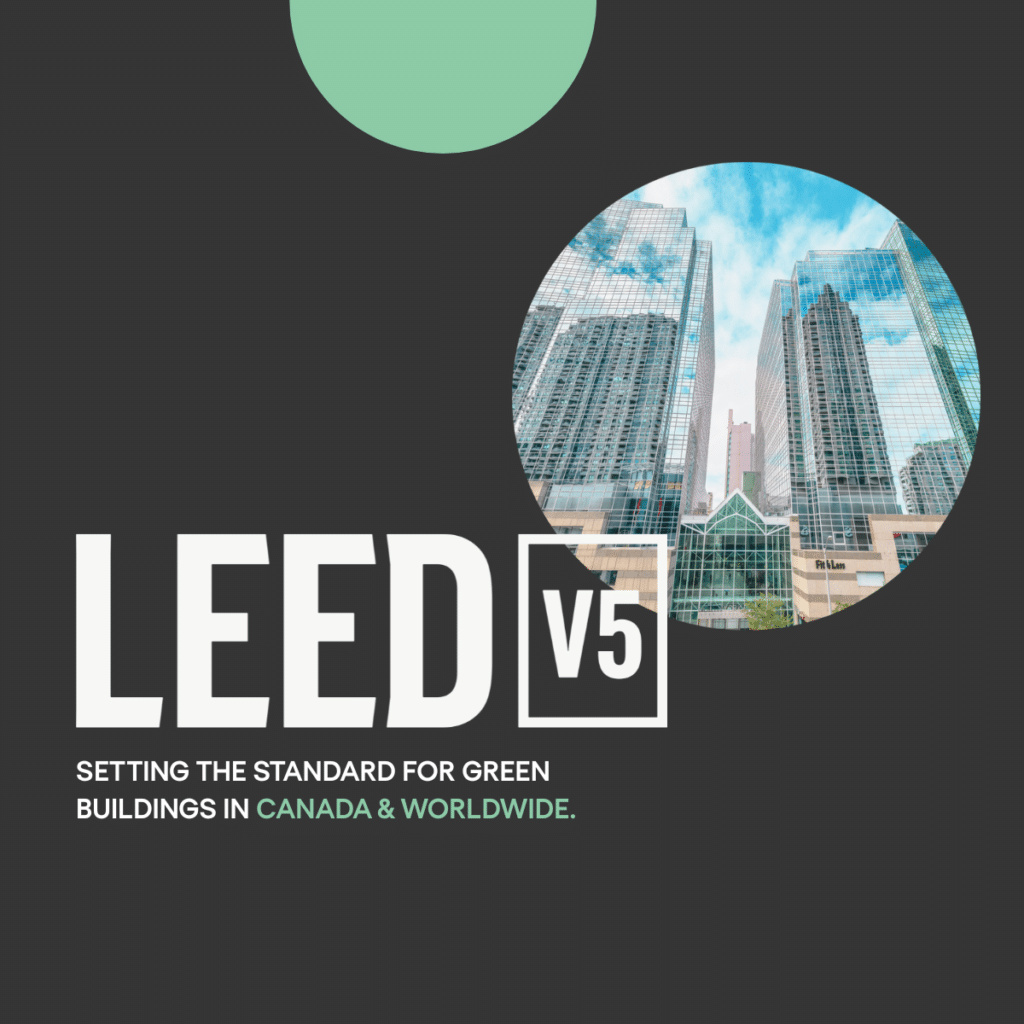Registration now open for LEED v5
The rating system that shaped green building in Canada raises the bar on sustainability.
CAGBC Staff on April 28, 2025
- Rating System/Standard
- LEED v5
Starting today, Canadian projects can register under LEED v5, the latest version of Leadership in Energy and Environmental Design®. The highly anticipated LEED v5 reimagines the world’s most widely used green building rating system, unlocking new ways to deliver improvements in ecological conservation and restoration, quality of life, and decarbonization.
Managed in Canada by the Canada Green Building Council® (CAGBC) to meet market needs and expectations, LEED provides a holistic framework for healthy, highly efficient, and cost-saving green buildings. Since the first Canadian LEED certification in 2002, LEED has been a driving force behind Canada’s green building movement. As a result of its broad adoption, there are over 6,280 LEED-certified projects in Canada, and the country is regularly listed among the top three LEED users in the world.

“Every new version of LEED raises the bar, balancing the limits of what is possible with industry readiness,” says Thomas Mueller, CAGBC’s President and CEO. “LEED v5 is ambitious with a stronger focus on decarbonization, resilience and health. With its trademark holistic approach, LEED v5 will support Canadian developers, owners, designers and builders in meeting changing investor, client and government expectations.”
LEED in Canada
Over the last two decades Canada’s building and real estate sector has embraced LEED to help design, construct and operate better buildings. There are LEED-certified buildings in every Canadian province and territory, spanning every sector, from healthcare and hospitality, to residential and industrial.
Working closely with USGBC, Canada plays a significant role in LEED’s development, collecting, consolidating and presenting Canadian feedback. For this version, CAGBC submitted 500 comments from its members to help improve LEED and ensure its applicability in the Canadian context.
“For over 20 years, LEED has shaped Canada’s green building sector, and in return, Canadian professionals continue to shape LEED. This approach has helped us achieve the best outcomes for the industry,” says Mueller.
For LEED v5, CAGBC members played a pivotal role, with the City of Calgary’s Adam Stoker (LEED AP BD+C, O+M and ND) acting as vice-chair of the USGBC’s LEED Design and Construction Consensus Committee, and Marsha Gentile (LEED AP BD+C) of Ledcor Construction, as a sitting committee member. Both are long-time CAGBC volunteers on the technical committees and working groups.
Perspectives from Canadian contributors
“It was an honour to highlight the invaluable perspectives that Canadians have contributed to the development of LEED v5,” says Stoker, Senior Sustainable Infrastructure Engineer, Climate and Environment for the City of Calgary. “Our unique insights into sustainable building practices and environmental stewardship have been crucial in shaping this new rating system. It has been a privilege to work alongside dedicated professionals from around the globe, ensuring that LEED v5 reflects the innovative and forward-thinking approach that Canada is renowned for.”
“As a Canadian member of the LEED v5 Design and Construction Consensus Committee, I am honoured to have contributed to the development of the next evolution of the LEED rating system,” says Gentile, Director, Sustainability for Ledcor Construction. “This role has provided a unique opportunity to ensure Canadian feedback, amassed and summarized by the CAGBC, reflects our regional diversity, climate realities and innovative approaches to green building. The valuable insights and priorities of the Canadian building industry have helped to create an inclusive, effective, and impactful LEED v5.”
What’s new in LEED v5
As of April 28, Canadian projects can register for LEED v5 Building Design and Construction (BD+C), Interior Design and Construction (ID+C) and Operations and Maintenance (O+M). LEED v5 introduces several significant updates to enhance sustainability in building practices and drive positive change with real-world impacts:
- Decarbonization focus: New prerequisites and credits emphasize reducing both operational and embodied carbon emissions. Half of LEED v5 credits are related to decarbonization.
- Enhanced energy efficiency: Stricter energy performance standards require projects to meet more ambitious efficiency targets, especially at the higher levels of certification such as LEED Platinum.
- Resilience: Integrates resilience to climate variability requiring projects to conduct climate resilience assessments to identify vulnerabilities and plan for long-term sustainability.

Projects can register under LEED v5 through the Arc platform. Interested projects will find initial reference guides available that provide introductory information as well as Credit Category overviews, reference standards and rating system and documentation requirements. Calculators, tools and forms are expected by the end of Q3, when projects will be able to submit for certification review.
Projects can continue to register under LEED v4 and v4.1 until the end of Q1 2026; projects will have six years after this date to submit for certification. For more information on LEED, visit cagbc.org/LEED.
LEED v5 resources
Find launch edition resources here: